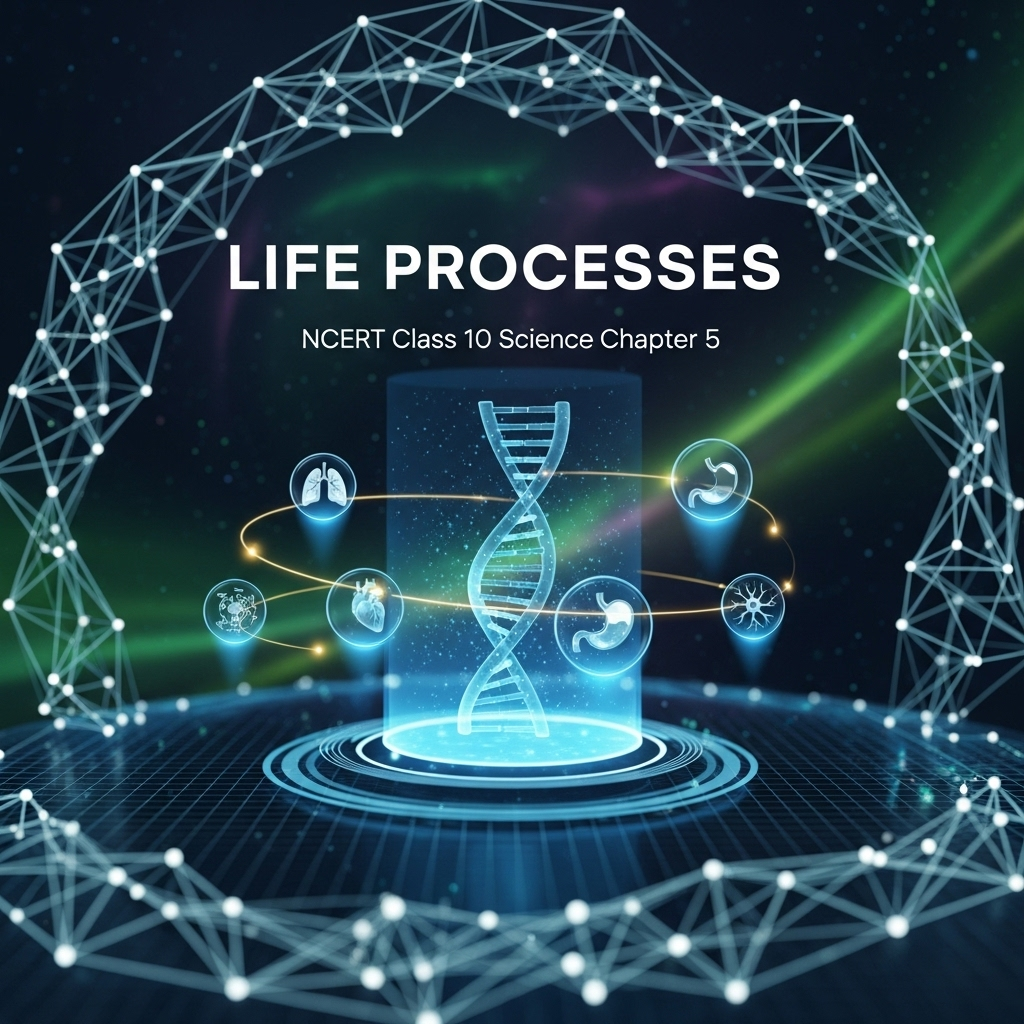Complete Solutions and Summary of Life Processes – NCERT Class 10, Science, Chapter 5 – Summary, Questions, Answers, Extra Questions
Comprehensive summary and explanation of Chapter 5 'Life Processes,' covering nutrition (autotrophic and heterotrophic), respiration (aerobic and anaerobic), transportation in plants and animals, excretion mechanisms, structure and functions of digestive, respiratory, circulatory, and excretory systems—paired with all question answers and extra questions from NCERT Class X Science.
Updated: 1 month ago
Categories: NCERT, Class X, Science, Biology, Summary, Extra Questions, Life Processes, Nutrition, Respiration, Transportation, Excretion, Human Body Systems, Chapter 5

Life Processes
Chapter 5: Science - Complete Study Guide | NCERT Class 10 Notes & Questions 2025
Comprehensive Chapter Summary - Life Processes Class 10 NCERT
Overview
- Chapter Purpose: Explains life processes maintaining life. Distinguishes alive/non-alive. Exam Tip: Focus on activities, diagrams, exceptions. Expanded Relevance 2025: Processes in biotech/health. Do You Know: Viruses debate. Figures: Leaf cross-section, stomata, human digestion. Key Insight: Molecular movements essential. Conservation: Sustainable nutrition.
- Broader Implications: Health, ecology, energy cycles.
Introduction: Distinguishing Alive from Non-Alive
- Visible signs: Movement (running dog, chewing cow, shouting man).
- Asleep organisms: Breathing indicates life.
- Plants: Green color, growth over time.
- Limitations: Not all plants green; no visible movement in some animals/plants.
- Molecular movements: Invisible, essential for life (viruses lack until infection).
- Why needed: Maintain organized structures against environmental breakdown; repair/maintenance via molecule movement.
5.1 What Are Life Processes?
- Maintenance functions: Continue even at rest/asleep.
- Prevent damage/breakdown: Need energy from outside (food via nutrition).
- Growth: Additional raw materials from outside (carbon-based).
- Nutritional processes: Vary by carbon source complexity.
- Energy conversion: Break/build sources into uniform energy (oxidizing-reducing reactions, often using oxygen via respiration).
- Single-celled: No specific organs; entire surface contacts environment.
- Multi-cellular: Specialized tissues; diffusion insufficient; need transportation for food/oxygen/waste.
- Excretion: Remove harmful by-products.
- Processes: Nutrition, respiration, transportation, excretion.
5.2 Nutrition
- Energy/materials: For maintenance, growth, synthesis (proteins).
- Food sources: Vary; autotrophs (inorganic CO2/water), heterotrophs (complex substances broken via enzymes).
5.2.1 Autotrophic Nutrition
- Photosynthesis: CO2 + water → carbohydrates (energy stored) via sunlight/chlorophyll.
- Unused carbs: Stored as starch (like glycogen in humans).
- Events: (i) Light absorption by chlorophyll; (ii) Light to chemical energy, water split (H2/O2); (iii) CO2 reduction to carbs.
- Steps not sequential: Desert plants CO2 at night.
- Chloroplasts: Contain chlorophyll; cross-section shows green dots.
- Activity 5.1: Variegated leaf starch test (green areas starch positive).
- CO2 source: Stomata (pores on leaves/stems/roots); guard cells open/close (swell with water).
- Activity 5.2: KOH absorbs CO2; no starch in that plant.
- Sunlight essential: Design experiment.
- Other materials: Water from roots; N/P/Fe/Mg from soil (N as nitrates/nitrites or organic via bacteria).
5.2.2 Heterotrophic Nutrition
- Adapted to environment/food: Stationary (grass) vs mobile (deer); cow/lion apparatus differ.
- Strategies: Break outside/absorb (fungi/yeast/mushrooms); whole intake/break inside (depends body design); parasitic (cuscuta/ticks/lice/leeches/tape-worms).
5.2.3 How Do Organisms Obtain Their Nutrition?
- Digestive system varies: Single-celled entire surface; complex specialized.
- Amoeba: Pseudopodia fuse over food → food-vacuole; break/diffuse; undigested out.
- Paramoecium: Definite shape; food at spot via cilia.
5.2.4 Nutrition in Human Beings
- Alimentary canal: Mouth to anus; specialized regions.
- Activity 5.3: Saliva (amylase) breaks starch (iodine test).
- Teeth: Crush food; saliva wets (smooth passage); amylase → sugar.
- Tongue: Mix/move food.
- Peristalsis: Rhythmic contractions push food.
- Stomach: Expands; walls mix with juices; gastric glands: HCl (acidic for pepsin), pepsin (protein), mucus (protect lining).
- Acidity: HCl excess causes complaints.
- Sphincter: Regulates exit to small intestine.
- Small intestine: Longest; coiled; length varies (herbivores longer for cellulose).
- Complete digestion: Liver bile (alkaline, emulsifies fats); pancreas (trypsin proteins, lipase fats); intestinal juice (proteins → amino acids, carbs → glucose, fats → fatty acids/glycerol).
- Absorption: Villi increase area; blood vessels transport.
- Large intestine: Absorbs water; undigested out via anus (anal sphincter).
- Dental caries: Bacteria on sugars → acids soften enamel; plaque; brush to remove.
SEO Note: Why This Guide?
Top-ranked for 'Life Processes Class 10 notes 2025'—free, with 60 Q&A from PDF, quizzes. Integrates nutrition, digestion, activities.
Key Themes
- Maintenance: Energy/raw materials.
- Autotrophic: Self-make food.
- Heterotrophic: Depend on others.
- Digestion: Break complex to simple.
- Human System: Specialized organs.
Cases for Exams
Explain photosynthesis steps; human digestion; activities results.
Exercises Summary
- Focus: Expanded to 60 Q&A: 20 short (1M), 20 medium (4M), 20 long (8M) based on NCERT + similar.
- Project Idea: Model digestion; test stomata. Group Activity: Photosynthesis simulation.
Group Discussions
No forum posts available.


